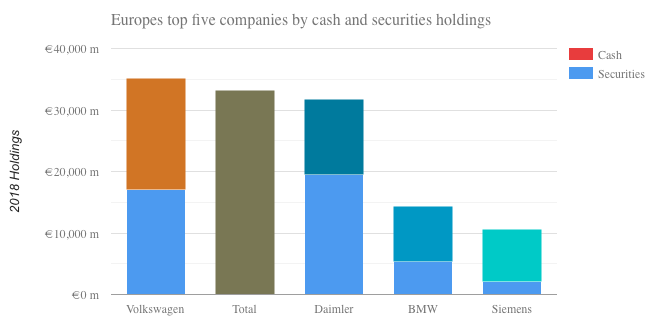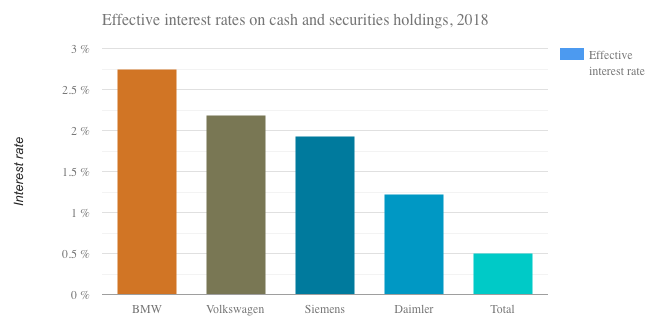Treasurers at VW, PayPal and BMW find innovative ways to beat Europe’s negative interest rates

The prospect of increasingly negative deposit rates in European currencies highlights the steps that treasuries are taking to boost returns on their cash portfolios.
The plunge of European interest rates into deepening negative territory has highlighted a conundrum for corporate treasuries. Sitting on large amounts of cash, how can they avoid being forced to pay for the privilege?
Analysis by EuroFinance of large company disclosures indicates that some companies in the euro area are making surprisingly healthy returns on their cash, 200 basis points or more than the benchmark deposit rate.

Consider Volkswagen Group, which has the largest holdings of cash and securities of all companies in the EuroStoxx 300 index. At the end of 2017, the company reported owning cash, securities, time deposits and intra-company loans of €44.7 billion, at a time when the one-year Euribor rate was –0.19 per cent. At the end of 2018, VW reported interest income of €967 million, earning an effective interest rate of 2.16 per cent. This figure excludes income from customer loans booked in the company’s financial services business.
Another example is industrial giant Siemens, which during 2018 reported €234 million of non-financial services interest income on €12.1 billion of cash and securities, equivalent to a 1.97 per cent interest rate. Beating both of them is auto giant BMW, which earned €397 million of interest income on €15 billion of cash and securities, equating to a 2.74 per cent annual return on these treasury assets.

Moreover, the cash and securities income reported by VW, Siemens and BMW outstrips the return earned by the biggest holders of such assets in the United States, where interest rates are 200 basis points higher. For example, Amazon and Microsoft recently reported interest income of 1.44 per cent and 1.93 per cent respectively.
Fund strategies
Publicly, the top-performing European companies are tight-lipped about their cash and securities income, while their accounts are relatively opaque compared with the US. But private conversations with senior treasurers reveal the innovative strategies that are being used.
Traditionally, companies deposited cash with banks, or money-market funds whose short-term investments could be categorised as ‘cash equivalents’. Accounting rules stipulate that such fund investments must be readily convertible to cash and ‘subject to an insignificant risk of changes in value’. Treasurers say that the shift away from the traditional approach began after the financial crisis highlighted the danger of bank counterparty risk and money market funds exposed to banks.

At this point, companies like VW, BMW and Daimler started diversifying away from cash and cash equivalents into new types of treasury funds – initially just corporate or sovereign bond funds and then also total return funds taking positions in equities, commodities and volatility. In return for accepting the influx of corporate cash, the funds have accepted tight risk controls based on value-at-risk models, treasurers say.
Companies are reluctant to publicly acknowledge the existence of these funds – not least because they don’t want them deluged by inflows of new cash which might lower returns. Under International Financial Reporting Standards, the funds that meet certain consolidation criteria are reported on a “look-through” basis in the annual accounts. In other words, the securities in the funds are reported, not the funds themselves.
Yet even if these securities include less liquid or more volatile assets, they are lumped together with cash and counted as ‘available liquidity’ in corporate accounts because of the funds’ low VaR. “Annualized volatility is indeed in the (very) low single digits”, one treasurer said.

According to Peter Reipen, a corporate treasury solutions partner at PwC in Germany who is familiar with some companies that use the strategies, claims of low volatility and high liquidity are justified: “These funds are very diversified and contain a large variety of different securities ”, he said. “Of course, assets in these treasury funds can be volatile. But then this needs to be publicly disclosed as such in terms of detailed fair value disclosures, sensitivity analyses or alternatively VaR scenarios”.
Using such strategies, treasurers say that they are able to beat a Euribor benchmark by 200 basis points or more. Inferring such returns directly from annual accounts is difficult, however, because interest income is not only earned from cash and securities managed by the funds but also intra-company loans which pay a small margin over external funding costs.
Under IFRS, companies are not required to disclose the components of interest income, even where this non-financial services income accounts for a substantial portion of earnings, such as with Volkswagen. Questioned by EuroFinance about the need for more disclosure, auditors say that the debate is a complex one.

“Views differ depending on stakeholders. Some consider more is needed while some consider that required disclosures should be simplified”, said Philippe Foerster, director in the capital market and accounting advisory services team at PwC in Luxembourg. “On top of IFRS requiring disclosure of every single significant component of financial statements, nothing prevents companies providing additional disclosure if this brings more clarity for the user of the financial statements”.
Boosting income with derivatives
An even more adventurous strategy involves FX derivatives, and here the disclosures of US online payments giant PayPal provide some clues. According to its latest 10-K filing, PayPal holds some $20 billion of customer funds, much of it in the Eurozone and other negative interest rate areas, in addition to $10 billion of corporate assets.

Rather than accept zero or negative yields on euro-denominated bonds, the company uses FX swaps to earn dollar-denominated returns on these assets. At the end of 2018, PayPal reported holding $10.7 billion notional of FX contracts ‘not designated as hedging instruments’, which boosted interest income by $45 million, resulting in an effective interest rate of 1.52 per cent. A PayPal spokesman confirmed that the accounts were accurate but declined to comment further.
According to a treasurer familiar with this kind of strategy: “The traditional idea of buying a bond with a maturity of 2-5 years and earning a given rate of return has morphed into something else. Now the best way to do that is to buy the asset in a different currency and hedge the risk back into my functional currency”. The treasurer acknowledged that this approach entailed taking additional bank counterparty risk.
At first glance, analysis of disclosures suggests that Siemens may be using FX derivatives in a similar way. Siemens’ German holding company owned €58.5 billion of currency hedging contracts at the end of 2018, up from €45 billion the previous year. However, despite the increase in derivatives, Siemens’ FX value-at-risk increased from €87 million to €103 million over the same period, consistent with the derivatives being used to boost income.
Responding to EuroFinance, a Siemens spokesman insisted that “Siemens engages in FX and interest rate transactions to minimize risk, only.” Satisfying this criterion is important for EU-based corporates because the European Financial Infrastructure Regulation (EMIR) exempts them from derivatives clearing on condition that their transactions are for hedging purposes. “If there were other transactions that did not fulfil the hedging character we would have to disclose these transactions against the EMIR thresholds”, the spokesman said.
This year 12 month Euribor rates plunged to -0.4 per cent, suggesting that treasurers may struggle to continue earning the positive returns that they have earned in the past. But armed with innovative strategies, some are confident that they will be successful in doing so, as a BMW spokesman said.
“BMW Group has an advanced liquidity management and we are confident that we will also in future be able to generate positive returns”.